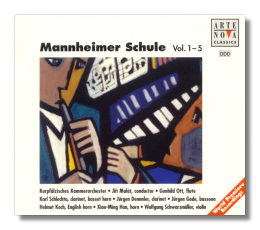
The Internet's Premier Classical Music Source
Related Links
-
Danzi Reviews
C. Stamitz Reviews - Latest Reviews
- More Reviews
-
By Composer
-
Collections
DVD & Blu-ray
Books
Concert Reviews
Articles/Interviews
Software
Audio
Search Amazon
Recommended Links
Site News
 CD Review
CD Review
Mannheimer Schule

Clarinet Concertos by The Mannheim School
- Carl Philipp Stamitz:
- Concerto for Clarinet #6 in E Flat Major
- Concerto for Clarinet #7
- Concerto for Clarinet #10
- Concerto for Clarinet #11 in E Flat Major
- Concerto for 2 Clarinets
- Concerto for Basset Horn
- Concerto for Clarinet & Bassoon
- Franz Danzi:
- Sinfonia Concertante for Clarinet & Flute, Op. 41
- Concertino for Clarinet & Bassoon, Op. 47
- Franz Anton Dimmler: Concerto for Clarinet
- Joseph Fiala: Concerto for Clarinet & English Horn
- Matthaus Frederic Blasius: Concerto for Clarinet #1 in C Major
- Johann Sebastian Demar: Concerto for Clarinet in E Flat Major
- Georg Friedrich Fuchs: Sinfonia Concertante for Clarinet & Horn in E Flat Major
- Franz Wilhelm Tausch: Concerto for Clarinet in E Flat Major
- Peter von Winter: Sinfonia Concertante for Violin, Clarinet, Horn, Bassoon
Karl Schlechta, clarinet and basset horn
Kurpfälzisches Kammerorchester/Jiří Malát
Arte Nova 74321-37327-2 DDD 5CDs: 70:55, 62:30, 62:53, 62:03, 67:39
This set samples the work of composers from the so-called "Mannheim School." All of them lived around the time of Mozart. The oldest, Carl Stamitz, was born in 1745, and the youngest, Johann Joseph Beer, in 1774. "Mannheim School" refers to the excellent musicians and musicianship to be found in that city during the latter half of the eighteenth century, thanks in large part to the enlightened patronage of Count Palatine Carl Theodor, who was a music lover. Excellent musicians attracted excellent composers, and even Mozart visited Mannheim in 1777 and again in 1778, in hopes of employment. (These hopes were not realized.) Apart from the composers mentioned above, other prominent Mannheim composers included Christian Cannabich and Ignaz Holzbauer, and Johann Stamitz, father of Karl, and sometimes known as the "father" of the Mannheim School. This milieu often is credited with providing an important link between the Baroque and Classical periods.
Eighteenth-century Mannheim was fertile ground for the maturation of the clarinet, which was a fairly new instrument at that time; the Mannheim orchestra was one of the first to include this reed instrument. As a result, concertante music for the instrument came into vogue. Over five hours of it appear on this set. To hear it is to be transported back to a period in European court history that was both intellectually and artistically stimulating. Nothing on these CDs is crucial – in the sense that Mozart's Clarinet Concerto is crucial – but the music is consistently well-crafted, undemanding, and very easy to listen to. It makes time pass quickly, which, come to think of it, was its purpose almost 150 years ago. If you want to feel noble and cultured, this is a good place to start. Some of the concertos are for clarinet alone. Others add a second clarinet, a bassoon, a flute, or an English horn. Peter von Winter's contribution is a Sinfonia concertante for violin, clarinet, horn, bassoon, and orchestra. One of Karl Stamitz's concertos is for solo basset horn – that instrument is a close relative of the clarinet. In spite of all the "reediness," my ears and brain never tired of listening to this music.
These performances were recorded in 1994-95 in the studios of the Südwestrundfunk. The Kurpfälzisches Kammerorchester appears to contain 12-15 musicians, which seems to be about the right size for this repertoire. Soloist Karl Schlechta bears the brunt of the solo work, and does so with facility, and the other soloists are fine too. The engineering is more than adequate. This set reminds me of the LP era's "Vox Box" – a big chunk of music reliably performed (often by less well known musicians) at a budget price. On this Arte Nova set, you certainly get more than your money's worth. Recommended, for listeners interested in this period of musical history.
Copyright © 2002, Raymond Tuttle



















